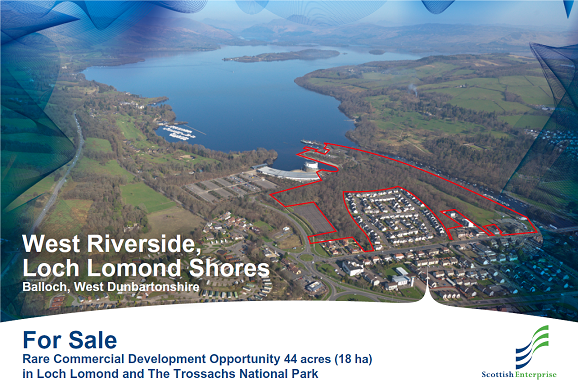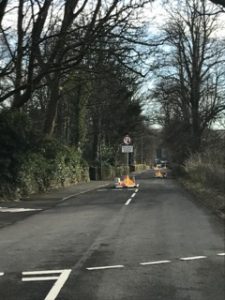
There is a case for tourism development at Balloch which goes all the way back to the Clyde Valley Regional Plan in 1949. That envisaged a number of developments along the south west corner of Loch Lomond segregated by green spaces. The problem is the developments now being proposed on the south shores of Loch Lomond are not being determined by the statutory objectives of our National Parks (conservation, public enjoyment of the countryside, sustainable development and wise use of resources) but rather by developers and financial interests. From a business perspective, the southern shores of Loch Lomond provide a massive development opportunity What’s at stake is far more than what is being proposed for the publicly owned Riverside Site at Balloch, although that is central to the commercialisation process, its about who Loch Lomond should be for and who should decide this. This post takes a look at the Flamingo Land proposals for Balloch within the wider context.
Flamingo Land
A number of people have argued that the main problem with Flamingo Land is its name and, if the company had marketed itself differently, there would have been far fewer objections to their proposals for the development of the Riverside Site. I believe this is totally wrong and is to misunderstand the nature of the company that Scottish Enterprise and the Loch Lomond and Trossachs National Park Authority appointed as preferred developer for the site.
Flamingo Land is not a small tourism business, it runs the third largest private visitor attraction in the UK. It has, I believe, little interest in smaller scale tourism developments. Its expertise lies in the operation of large resorts (nothing wrong with that but inappropriate for a National Park). While the Riverside Site marketed by Scottish Enterprise comprises 18 hectares of public land, the development opportunities there were constrained by the need to maintain some public access and, by itself, it was too small to meet Flamingo Land’s aspirations. As evidence for that I would cite Flamingo Land’s subsequent purchase of Woodbank House and grounds. Also the fact that its Planning Application covers a far greater area than was earmarked for development in the Local Development Plan (see here). In other words, Flamingo Land, supported by Scottish Enterprise, is pushing for a far greater development than the LLTNPA ever envisaged.
Unfortunately, instead of having a coherent vision for the south shores of Loch Lomond supported by the public, the LLTNPA has dug a hole for itself. On the one hand it promised Scottish Ministers to deliver the development of the Riverside Site and was on the interview panel which appointed Flamingo Land as preferred developer. This has effectively put the boot on Flamingo Land’s foot. On the other hand, through its failure to consult people properly about what sort of development might be appropriate on the Riverside Site and the wider area, the Local Development Plan is deeply flawed. The result is that the LLTNPA has been unable to draw lines. Instead of being able to tell Flamingo Land its proposals were unacceptable, it has suspended the Planning Application process and now been involved in five months of secret negotiations.

Worse, the LLTNPA’s approval for the upgrading of the private road linking Cameron House to Balloch (see here), paves the way for an even larger “resort”. I have no evidence that Flamingo Land in interested in taking over Cameron House at present, but there is no doubt the road is in its interests. Although the planning permission was temporary, there was no requirement to remove the new road once Cameron House was complete, and this will allow customers of the two businesses to connect (rather than have to take the long way round by the A82). At the very least it has increased the land values at Woodbank where Flamingo Land is now proposing to build a number of large houses: the attraction of a direct link to the Cameron House golf course should not be underestimated.
This process of planning creep, which results from the LLTNPA’s failure to develop a coherent plan endorsed by the public, suits Flamingo Land only too well. We need to put an end to it and draw lines. To do so means the LLTNPA starting again and consulting on a plan for the whole of the south west corner of Loch Lomond. It could do so through the means of a masterplan with widespread consultation which gave a real say to community and wider interests.
Scottish Enterprise renews its Exclusivity Agreement with Flamingo Land
Unfortunately, this appears unlikely to happen. Ten days ago the new broke that Scottish Enterprise had extended its Exclusivity Agreement with Flamingo Land for another two years until 2020 because plans “have taken longer than expected” (see here). This shows that Scottish Enterprise are determined to see its joint Planning Application with Flamingo Land for the Riverside Site going ahead. It put a legal block on the possibility of the community buying any part of the site and developing alternative proposals:
“If you have entered into an option agreement before a Community Body’s application to register an interest in your land has been submitted to Scottish Ministers, the application from the CB will not be considered. If, however, Ministers find that an option agreement put in place after a valid application has been submitted to them, it will be deemed to have no effect.”
Extract from https://www.gov.scot/publications/community-right-buy-guidance-applications-made-15-april-2016/. The Exclusivity Agreement is a type of options agreement and effectively prevents the Boat Clubs or other organisations concerned about the impact of Flamingo Land’s proposals from putting in an alternative bid for the land.
Despite its rhetoric about supporting community involvement, the LLTNPA has been completely silent about how Scottish Enterprise is trying to shut out the local community at Balloch.
The latest development proposals for the Ward’s Estate
Given the carte blanche to Flamingo Land at Balloch, its not surprising that other developers don’t see why they shouldn’t get in on the act. The Ward’s Estate on the south-east corner of Loch Lomond, adjacent to the Loch Lomond National Nature Reserve, wase granted planning permission in August 2015 for a mini-tourism development, “holiday let accommodation and function venue with marquee and portable toilet area, erection of detached garage and gazebo and change of use of wetland area to garden ground”. Then, in 2016, they lodged a further application for a larger development (see here for planning papers) described as follows:
“erection of building comprising café/shop and associated parking area; 2 tourism accommodation units with associated swimming pool/leisure buildings; manager accommodation unit; formation of an access road and footpath network; installation of a bird hide; external play area and associated toilet facility and landscaping”.
This stalled until late last year when the size of the development was reduced and it was re-advertised. It has run into a wave of public criticism which has attracted national publicity because of the owner’s colourful past (see here). The Friends of Loch Lomond and Trossachs (I am a member) have rightly objected (see here) stating:
In our last submission we highlighted our concern about creeping suburbanisation in the sensitive
countryside area between Balloch , Gartocharn and Drymen and this proposal, if approved, would
contribute significantly to the further erosion of countryside which is noted for its special high value
scenic and conservation qualities. It is totally inappropriate to introduce 6 new large buildings and
associated car parking and access roads in this area.
Those arguments are, in my view, equally appropriate to the south west corner of Loch Lomond.
The LLTNPA’s lack of any coherent planning framework for the southern shores of Loch Lomond is demonstrated by this extract from the Supporting Statement for the revised Ward’s Estate application:
On the basis of ongoing discussions with the National Park Authority the footpath network, bird hide, and external play area are now no longer being proposed.
So, the LLTNPA appears to be only too happy to draw lines limiting access, despite its public duty to promote public enjoyment of the countryside (this land is outwith the National Nature Reserve), but not to draw lines about the sub-urbanisation of the countryside in what is a National Scenic Area. This is all wrong and will embroil the Park in another planning stushi.
What needs to happen
Instead of their current piecemeal approach to planning, the LLTNPA needs to take a wider look at areas like the southern shores of Loch Lomond in response to the development pressures they face (it should have taken a similar holistic approach to areas faced with multiple hydro developments). It should then engage with local communities and the wider public to develop a spatial planning framework for each such area which is far more comprehensive and clear than the current Local Development Plan and popularly endorsed. Such a framework would, I think, result both in lines being drawn on maps to show where development would and would not be allowed (Drumkinnon Woods for example) and what type of development would be allowed (avoiding nebulous concepts like “visitor experience”).
Our current planning system of course is not conducive to this, being focussed on promoting development rather than land-use, but there is room within it to develop plans of the type I am suggesting. Examples include masterplans – why isn’t there one for Balloch? – and the current intiatives in Scotland to develop Local Plans. The LLTNPA itself has also recognised the need for area based approaches in the Supplementary Planning Guidance it has produced for east Loch Lomond, although this involves more vague policy guidance rather than clear spatial allocations of land for particular purposes which I am advocating.
With a number of prominent politicians now actively speaking out against the Flamingo Land Development – local SNP MP Martin Docherty recently issued a series of tweets explaining why he opposed the development – and with the Greens encouraging more people to object, the LLTNPA needs to find a way out of the Riverside logjam. If it keeps pressing ahead with trying to make Flamingo Land work, it will face two more years of strife and risks losing what little reputation it has left. Far better for its new Board to acknowledge the impasse, admit the LLTNPA has in the past made mistakes that have contributed to this and start again by working with the public, rather than developers, to agree a plan that has widespread public support.

I have been in meetings with fl people,they dont give much info out.I was told after the meeting by a well known mp,no objections to planning are even considered unless you give a reason why you object.
Hi John, you are right that the planners will discount objections unless people give what are known as “material” reasons for objection. There are lots for Flamingo Land with almost half the land covered by the Planning Application not being earmarked for the developments they propose in the Local Development Plan and much of the rest of the development being contrary to Park policy. I have highlighted more details about this in past posts. Nick
They seem to have confused Balloch with Blackpool. Totally INappropriate development for this area. I can remember the wee motor boat hire place near the bridge. Happy days….